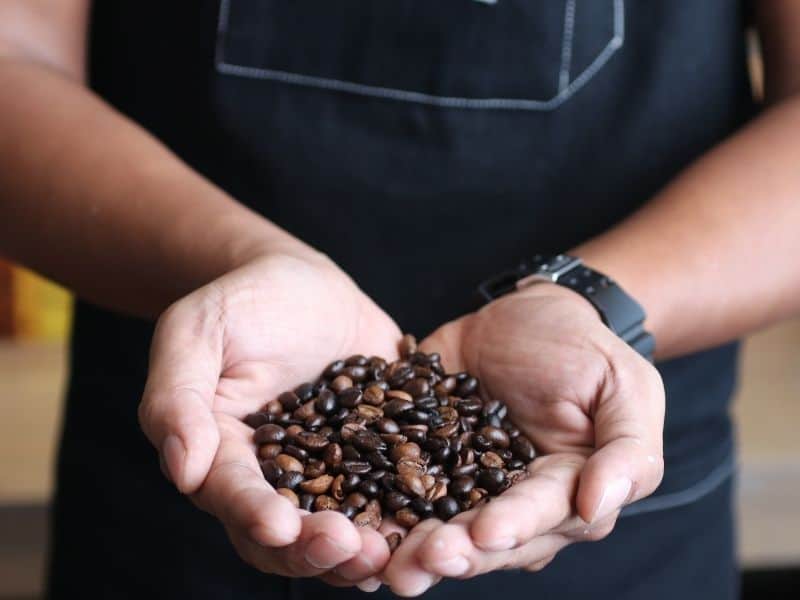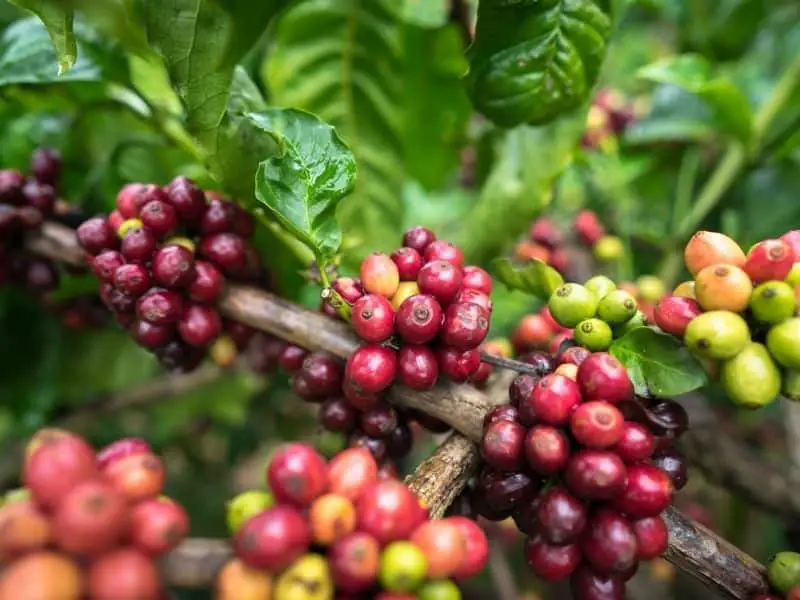Coffee is one of the most popular beverages in the world, ranking third in popularity after water and tea. But, where does coffee come from?
Let’s delve into this a little deeper.
Where does coffee come from?
Coffee, the drink, is made from what we call the coffee bean.
The coffee bean is actually the pip of a berry, the seed of the fruit on the Coffea plant, of which there are two main types: They are Coffea Arabica which provides Arabica beans, and Coffea Canephora, from which becomes Robusta beans.
The ideal climatic conditions for growth are in what is called the Coffee Belt, a region around the equator between the Tropics of Cancer and Capricorn.
This is where nearly all world coffee is grown.
However, there have been attempts to establish coffee plantations in as far north as Spain and California, although with some difficulty, and with some doubts about the quality compared to plantations in the Coffee Belt.

Where does the coffee plant originate from?
Coffee, according to legend, was first discovered in Ethiopia, before the 15th Century. We even somehow know the name of the goat-herder who discovered it, Kaldi.
So apparently Kaldi was tending his flock when he noticed the goats became a bit frisky after eating the berries from a certain tree.
He reported his findings to the local monastery, where the abbot made a drink out of the berries and found this kept him awake through long nights of prayer.
It was not long before commerce intervened, and someone else started harvesting the beans and selling them as a tonic.
While much of this is more myth than fact, what we do know is that plants were taken to Southern Arabia in the 1500s where they were cultivated, and from there spread along the trade routes to all corners of the known world.
What does a coffee plant look like?
We often hear the coffee plant spoken of as a tree, but it is in fact a shrub.
The difference is that a tree has one main stem, the trunk, which increases in size every year, and from which sprout branches that form a crown.
A shrub, like the coffee plant, grows a number of stems and branches straight from the ground, and the whole shape is a crown of branches.
It is easy to see why coffee plants are sometimes seen as trees though. Left uncultivated they can grow to as high as ten meters!
In cultivation they are normally a maximum of five meters, to make harvesting easier especially since much handpicking is used in coffee plantations

How long does it take for a coffee plant to grow?
Depending on the conditions, a cultivated coffee plant will start to produce fruit in three to four years.
It is an unusual plant in that the coffee cherries which contain the seed or bean can be at various stages of ripeness at the same time on the same plant. This gives a good long harvesting season.
It is estimated that the life of a coffee plant is up to 100 years, although on a commercial plantation the best producing years are between 7 and 20.
It is possible to grow small coffee plants at home for decorative purposes. They are an attractive plant and very hardy, so even the laziest home gardeners will be able to grow them with some success.
Where are coffee plants grown today?
Coffee is cultivated in more than 70 countries around the world. However, only 5 of those countries provide the majority of the coffee consumed today.
In first place is Brazil, and it has been the biggest producer since the 1840s, with over 300,000 coffee farms producing Arabica beans. Frank Sinatra even had a hit in 1946 with the song “They’ve Got an Awful Lot of Coffee in Brazil”.
Second, surprisingly is Vietnam, which has found a niche in becoming the biggest exporter of Robusta beans in the world. Robusta in its natural state is harsher and stronger in caffeine than Arabica and is used mainly in instant coffee, powdered or granulated.
The others in the top five are Colombia, Indonesia, and still Ethiopia, home of the first coffee plant.
How are coffee beans made?
What we know as a coffee bean is actually the seed from the cherry on the Coffea plant.
If a raw seed is planted in fertile ground it will grow into a coffee plant.
Once the cherry is picked, the seed is removed.
There are several methods for this, the most common being washing most of the fruit pulp off, then fermenting the seeds underwater for a few days to remove the rest of the pulp.
The seeds are then dried either in the sun or in drying machines.
The end result is the green bean, which is stored until roasted.
What animals produce coffee beans?
The world’s most expensive coffee is actually produced by animals, by elephants actually.
In Thailand, elephants are fed coffee beans which are later picked out of their droppings and then processed. The elephant is a highly regarded and sacred animal in Thailand, and coffee produced in this way is very sought after.
This practice also occurs in other regions. In Vietnam and Indonesia, beans are fed to small civet cats and recovered from their droppings, and then roasted.
While this may seem just a novelty, it has a practical purpose.
Using mainly Robusta beans, the stomach acids and gastric juices partially ferment the seeds, removing the harsh taste of the Robusta bean, and adding an earthy, deeper flavor.
In Indonesia it is called Kopi Luwak, the Luwak being their name for the Civet. In Vietnamese cafes, it is known as Ca Phe Cut Chon, which loosely translates as “Weasel Dung Coffee”.
If you get the opportunity, you should certainly try this unique coffee style – but make sure the beans are carefully washed first!
Final thoughts on where coffee comes from
As you can see, coffee has a rich history, as rich as a freshly brewed cup of joe.
While the coffee industry is not seen as a traditional agriculture industry, it certainly has countless stories about harvesting, producing, and recycling.
So the next time you are trying to figure out where does coffee comes from or how is it made, hopefully, this article will have given you some insight.

